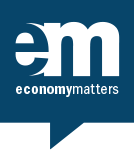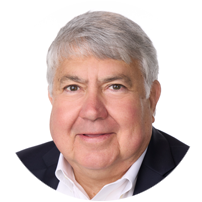
Atlanta Fed president Raphael Bostic onstage with Juliette Pryor, chair of the board of trustees of Fisk University
Atlanta Fed president Raphael Bostic recently discussed his process for determining the monetary policy he thinks will be best able to foster stable prices and sustained maximum employment.
Speaking to an audience in Nashville, Bostic said he factors three information sources into his decision making. One is national and regional data and statistics on topics such as employment and inflation. Second, he uses survey results from business executives on their expectations for hiring, pricing, and more. Third, he considers information gleaned from the Bank's unstructured conversations about the economy with a revolving group of 60 to 120 business leaders. The latter two information sources provide important forward-looking perspectives on the economy, ensuring that he has a broad understanding of where the economy is going, and not just where it's been.
"My job is to take these three narratives and pull them all together into a large-scale narrative, and that's the narrative I use to inform what I think is important for monetary policy," Bostic said. He then presents this narrative to the Federal Open Market Committee, where he serves this year as a nonvoting participant in the group that meets eight times a year to set short-term interest rates, among other responsibilities.
Bostic's brand of transparency is an example of the Federal Reserve's break from its former, longstanding policy of holding its cards close to the chest. As Bostic explained, "We really do want everyone to understand what we do and what we're seeing, so that we can help make this an economy that works for everyone."
Explaining his approach to determining an appropriate monetary policy stance was among several topics Bostic addressed during an hourlong conversation hosted October 7, at Fisk University, by the Nashville Area Chamber of Commerce, the Atlanta Fed, and Fisk University. Fisk board chair Juliette Pryor moderated the chat with Bostic. Nashville was the latest destination on Bostic's itinerary as he visits with business, civic, and nonprofit leaders in the Sixth District, comprising Alabama, Florida, Georgia, and parts of Louisiana, Mississippi, and Tennessee. While in Nashville, Bostic also met with a group of area high school teachers.
Pryor—a Fisk alumna whose day job is executive vice president, chief legal officer, and corporate secretary for Lowe's Companies Inc.—prefaced her question to Bostic about housing affordability by citing the Atlanta Fed's recent analysis of rising housing prices in greater Nashville and other southeastern cities. Pryor observed that Fisk has encountered difficulties in attracting faculty and staff as area housing prices have increased. She said other regional employers face similar challenges in recruiting and retaining personnel. The Atlanta Fed's study showed the median home price in Nashville has increased 62 percent since 2019, a rate hike that far outpaces the housing budget of the region's median household income of $90,500.
Bostic offered two perspectives, informed by a career spent evaluating housing needs and housing market conditions to inform public policies and programs. First, he noted, housing is subject to the law of supply and demand: housing prices rise as demand exceeds supply. Second, even wage hikes that might be intended to close the affordability gap won't fix the problem if demand continues to exceed supply, because prices likely will rise commensurately.
"Affordability is a ratio. It's the cost over income," Bostic said. "You can address affordability on the income side. But there is this fundamental baseline of supply. If there is an imbalance between demand and supply, supply has to be part of the solution." Bostic noted that several cities in the Southeast are considering an array of shifts in land-use policies that are intended to boost the housing supply, including allowing greater residential density in neighborhoods and permitting residences to be built in industrial areas.
Pryor asked Bostic to discuss the Federal Reserve as an institution now at the center of public discussion, specifically, "how we should think about the responsibilities that the organization has, and the implications of its independence and ability to execute on monetary policy, given the spotlight on the Federal Reserve and the challenges that the organization is currently facing?"
Bostic responded, "I'm going to broaden this out, because I think it's a bigger issue. The Federal Reserve is an institution. I think there has been a lot of questioning and spotlights on the role of all institutions. There's been a lot of discussion about higher ed, for example, about hospitals and health care. The Federal Reserve is on the list of institutions where that matters."
Bostic said the Fed has a clearly defined set of goals: to foster stable prices and maximum employment. In addition to this congressional mandate, the Fed must consider the effect of its policies over the longer term. Bostic said he views the key to his job as remaining dispassionate and analytical as he focuses on making policy decisions intended to promote economic stability and sustained maximum employment.
"I feel the institution has a good chance to retain its independence," Bostic concluded. "We understand our charge. It creates tension sometimes. But central banks across the world all face the same tensions. If you're going to take this job, you have to understand that's part of what the role is."
Bostic fielded a range of other questions from Pryor and the audience:
- On generative artificial intelligence: Bostic said it differs from other disruptors because it will touch workers in all sectors and at all skill levels.
- On a potential recession: Bostic said he's not aware of anyone thinking a catastrophe is on the horizon, though some consumers are scaling back their purchases.
- On how the private sector can partner with the nation's federally designated Historically Black Colleges and Universities (HBCUs), such as Fisk University: Bostic said the current discussion over funding models for universities presents a gateway for such conversations to maintain the vibrancy of HBCUs. "The HBCU community has unlocked and unleashed talent that has benefited the whole country, and continues to do that," Bostic said. "Investments in those institutions will continue to be critical."
As the session ended and Pryor asked Bostic if he had any concluding remarks, he returned to the notion of transparency. Bostic encouraged the audience to take informational materials the Atlanta Fed had provided, sign up for communications, and answer the phone if the Fed calls. "Take the call and talk to our folks," Bostic said. "They will bring that information to me in Atlanta."




